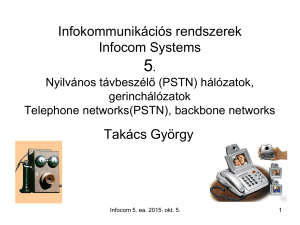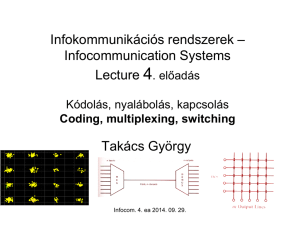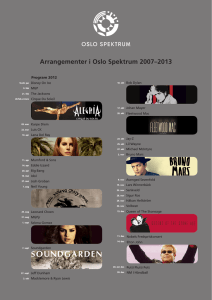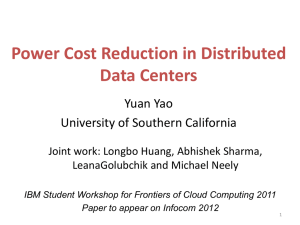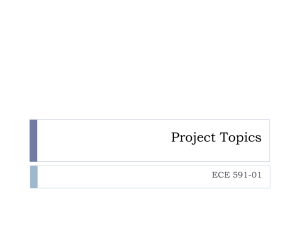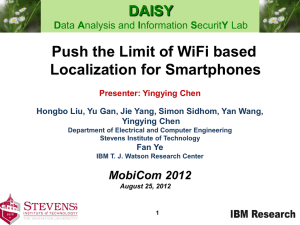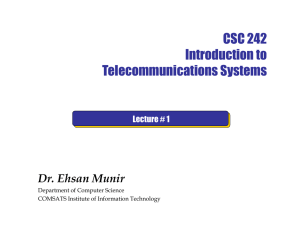Public Switched Telephone Networks
advertisement
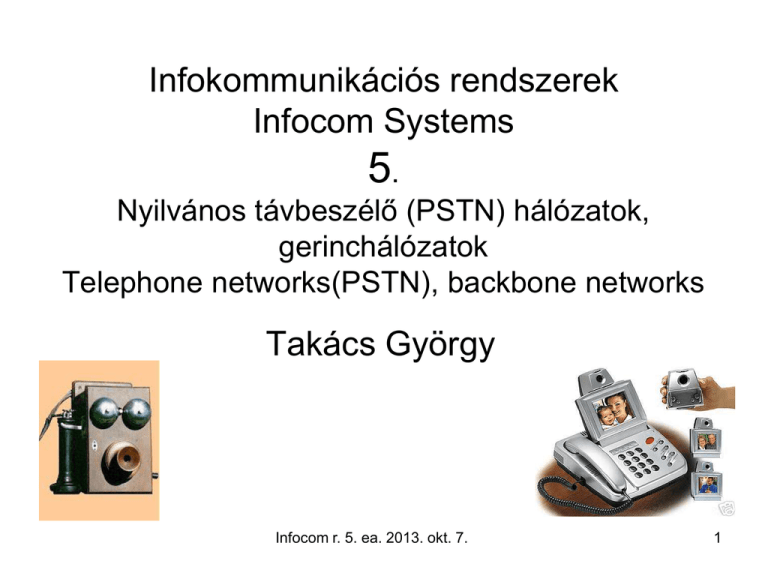
Infokommunikációs rendszerek Infocom Systems 5. Nyilvános távbeszélő (PSTN) hálózatok, gerinchálózatok Telephone networks(PSTN), backbone networks Takács György Infocom r. 5. ea. 2013. okt. 7. 1 The 3 lessons in network studies • Public Switched Telephone Networks (PSTN), Integrated Service Digital Networks (ISDN), backbone networks • Mobile Networks -- Public Land Mobile Networks (PLMN) GSM, UMTS, DECT, TETRA, Bluetooth, Globalstar, Iridium • Private networks, Broadcasting networks, Cable TV networks (CaTV) Infocom r. 5. ea. 2013. okt. 7. 2 Infocom r. 5. ea. 2013. okt. 7. 3 Gyorsjelentés 2013. augusztus Infocom r. 5. ea. 2013. okt. 7. 4 Infocom r. 5. ea. 2013. okt. 7. 5 Infocom r. 5. ea. 2013. okt. 7. 6 Infocom r. 5. ea. 2013. okt. 7. 7 140.0 120.0 100.0 80.0 Series1 60.0 Series2 40.0 20.0 0.0 J–M Á–Jú Jl–Sz O–D J–M Á–Jú Jl–Sz O–D J–D J–M Á–Jú Jl–Sz O–D J–D J–M Á–Jú Jl–Sz O–D J–D J–M Á–Jú 2009. 2010. 2011. Infocom r. 5. ea. 2013. okt. 7. 2012. 2013. 8 Infocom r. 5. ea. 2013. okt. 7. 9 Infocom r. 5. ea. 2013. okt. 7. 10 Infocom r. 5. ea. 2013. okt. 7. 11 Infocom r. 5. ea. 2013. okt. 7. 12 Infocom r. 5. ea. 2013. okt. 7. 13 Special features of networks • Only services can be sold on the real market! • There are not electronic communication services without networks. • You could not buy networks. You have to plan, to construct, to operate, to develope according to the actual demands and to eliminate at the and of service provision. Infocom r. 5. ea. 2013. okt. 7. 14 Basics of network components • Backbone networks: long distances, high traffic, interconnection of nodes, transport bits of any services, high relability. • Access networks: local distances, interconnection of terminals and local nodes • Network planning: selecting topology, optimal selection of positions of nodes, dimensioning of node traffic handling capacities, dimensioning of link capacities, selecting technologies. Infocom r. 5. ea. 2013. okt. 7. 15 Infocom r. 5. ea. 2013. okt. 7. 16 Infocom r. 5. ea. 2013. okt. 7. 17 Infocom r. 5. ea. 2013. okt. 7. 18 Infocom r. 5. ea. 2013. okt. 7. 19 The pan European KPNQwest network, when complete, will connect major cities together by six high-capacity backbone rings. Infocom r. 5. ea. 2013. okt. 7. 20 AOL USA BACKBONE Infocom r. 5. ea. 2013. okt. 7. 21 Infocom r. 5. ea. 2013. okt. 7. 22 Infocom r. 5. ea. 2013. okt. 7. 23 Infocom r. 5. ea. 2013. okt. 7. 24 Infocom r. 5. ea. 2013. okt. 7. 25 Public Switched Telephone Networks (PSTN) • • • • • • Brief history Basics Network structures Network implementation Network development trends Missing topics Infocom r. 5. ea. 2013. okt. 7. 26 Brief history I. • 1876 A. G. Bell Patent of telephone (50.000 phone within 3 years) • 1877 T. A. Edison patent of carbon microphone (covering long distances) • 1878 Puskás Tivadar the first telephone exchange in Connecticut • 1881 Puskás Ferenc the first telephone exchange in Budapest • 1890 The first Wien-Budapest international telephone connection • 1892 The first automatic telephone exchange in Indiana • 1928 The first automatic telephone exchange in Budapest • 1997 The last manual exchange moved to museum in Hungary Infocom r. 5. ea. 2013. okt. 7. 27 Infocom r. 5. ea. 2013. okt. 7. 28 Infocom r. 5. ea. 2013. okt. 7. 29 Brief history II. • The technical level of Hungarian PSTN networks are very high due to the fast development from 1992-2002 • From 1 million subscriber to 10 million one • From 1000 manual exchange to almost fully digital network • COCOM list restriction not from our side!!! Infocom r. 5. ea. 2013. okt. 7. 30 Basics of telephony • • • • • • • 2/4 wire for voice Feeding of circuit Access solutions Backbone Signalling basics for a telephone call Source of revenues ADSL principles Infocom r. 5. ea. 2013. okt. 7. 31 2/4 wire for voice 2 wire simplex 4 wire simplex 2 wire duplex Infocom r. 5. ea. 2013. okt. 7. 32 Electronic hybrid circuit Zg r r Twisted pair cable Z0 characteristic impedance ZT ZT ~Z0 Infocom r. 5. ea. 2013. okt. 7. 33 Powering of telephone sets Feeding bridge Traditional feeding bridge circuit Subscriber line Local exchange Infocom r. 5. ea. 2013. okt. 7. DC line current: 20….60 mA 34 Access solutions Infocom r. 5. ea. 2013. okt. 7. 35 Connections to the local exchange Main cables Distribution cabinets Distribution cables Distribution boxes Drop cables, Indoor cables Infocom r. 5. ea. 2013. okt. 7. 36 Access network implementation Infocom r. 5. ea. 2013. okt. 7. 37 Cable duct system implementation Infocom r. 5. ea. 2013. okt. 7. 38 Cable distribution cabinet (street version) implementation Infocom r. 5. ea. 2013. okt. 7. 39 Signalling basics for a telephone call Infocom r. 5. ea. 2013. okt. 7. 40 Channel-associated signalling for a trunk call Infocom r. 5. ea. 2013. okt. 7. 41 Common-channel signalling for a trunk call Infocom r. 5. ea. 2013. okt. 7. 42 Backbone issues in a small country with dense population • Fully optical – only spare radio connections • Covered distance between nodes max 100 km • In Hungary the telecom traffic concentrated in Budapest and towards Budapest (like the road traffic) • Concentration of switching capacities in higher level nodes • Fault tolerant topology is required for reliable services Infocom r. 5. ea. 2013. okt. 7. 43 Network structures • • • • • • Basics MATÁV structures PANTEL structures Interconnection issues Structure and numbering Intelligent Network Concept Infocom r. 5. ea. 2013. okt. 7. 44 Basic structures in PSTN/ISDN networks • • • • • Star topology Multipolar topology Meshed topology Ring topology Bus topology Infocom r. 5. ea. 2013. okt. 7. 45 STAR BUS RING MESHED MULTIPOLAR Infocom r. 5. ea. 2013. okt. 7. 46 MATÁV NETWORK STRUCTURE Infocom r. 5. ea. 2013. okt. 7. 47 Telephone network structure of MATAV Secondary exchange Backbone network Primary exchange Local exchange Inter exchange network Access network Subscriber Infocom r. 5. ea. 2013. okt. 7. 48 PKI Távközlésf ejleszt ési I nt ézet H álózat f ejleszt ési ágazat Infocom r. 5. ea. 2013. okt. 7. 49 . P K I Távközl ésf ej leszt ési I nt ézet H álózat f ej leszt ési ágazat Infocom r. 5. ea. 2013. okt. 7. 50 3. Layer Network layer 2. Layer Data link layer IP link 1. Layer Physical layer Optical cable Infocom r. 5. ea. 2013. okt. 7. 51 Infocom r. 5. ea. 2013. okt. 7. 52 Infocom r. 5. ea. 2013. okt. 7. 53 PANTEL optical backbone structures Infocom r. 5. ea. 2013. okt. 7. 54 PANTEL logical SDH rings Sim plifie d s tructure of PanTe l SDH back bone ne tw ork STM-4 to 2*STM-1 to UTA Slovakia 2*STM-1 to PTA These STM's include leased lines to Frankfurt, Amsterdam and Praha S opron Ring #4/b (2 nodes) Ring #1 (19 nodes) H halom C sorna MA N (11 nodes) Ring #4 (18 nodes) (B p. total: 18 nodes) Ring #3 (12 nodes) Ring #2 (5 nodes) Not closed!! Total number of nodes : 75 Ring #5 (8 nodes) August 2000 ( Is s u e : 1 8 . Au g u s t 2 0 0 0 , L a s z lo Zo r k o c z y ) Infocom r. 5. ea. 2013. okt. 7. 55 Interconnection principles Infocom r. 5. ea. 2013. okt. 7. 56 Interconnection principles Infocom r. 5. ea. 2013. okt. 7. 57 Interconnection implementation Infocom r. 5. ea. 2013. okt. 7. 58 Network structure and numbering Infocom r. 5. ea. 2013. okt. 7. 59 Network implementation • Access issues: Rural, City, Down-town, areas, In-door cabling, Underground copper cables, Overhead cables, ADSL, Fibre To the Curb (FTC), distribution frames • Core issues: Underground fibres, overhead fibres, • Switching and multiplexing position of nodes • Traffic issues: dimensioning of switches and links Infocom r. 5. ea. 2013. okt. 7. 60 Access network implementation Infocom r. 5. ea. 2013. okt. 7. 61 Costs and revenues The revenues are monthly fees and traffic based fees Network costs Wireline networks Cellular networks Traffic density (Erlang/km2 Infocom r. 5. ea. 2013. okt. 7. 62 Telephone bill balance balance balance time Pre-paid time balance time Post-paid Infocom r. 5. ea. 2013. okt. 7. 63 Infocom r. 5. ea. 2013. okt. 7. 64 ADSL principles • • • • • • • • • • • ADSL =Asymmetric Digital Subscriber Line Download max 8Mbit/s (usually 1,5 Mbit/s) Uplink 64-256 kbps Max covered distance 3,6 km ITU-T G.992.x standards The frequency band separated in 3 parts: PSTN/ISDN, uplink, downlink Data links 4,3125 kHz channels Discrete Multi Tone (DMT) coding, 256 channels 1-5 channels for PSTN/ISDN 32 channels for uplink 218 channels for downlink Infocom r. 5. ea. 2013. okt. 7. 65 ADSL principles PSTN/ISDN UPLINK DOWNLINK Carrier frequencies Time frames: one octett in each frequency Infocom r. 5. ea. 2013. okt. 7. 66 ADSL principles To ISPs Infocom r. 5. ea. 2013. okt. 7. 67 Missing topics • Telephone sets, terminal equipment (Lecture in Nov ) • Services (Lecture in Nov ) • Regulation issues (Lecture in November ) • Details of ADSL • NGN (Next Generation Networks in December) • Network planning (optional subject in semester 7.) Infocom r. 5. ea. 2013. okt. 7. 68 Network development trends Traditional Solutions in Future Solutions Data/IP Networks Data/IP Networks Services/Applications PSTN/ISDN PSTN/ISDN Services Connectivity Access Transport & Switching Networks Infocom r. 5. ea. 2013. okt. 7. 69 Infocom r. 5. ea. 2013. okt. 7. 70
